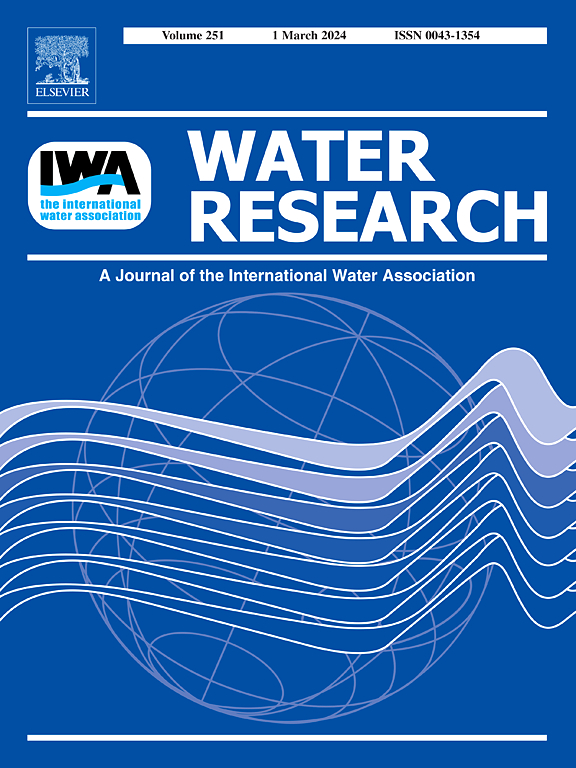优化 AAO 工艺,减少 N2O 排放并提高城市污水处理中的脱氮效果:探索碳补充和溶解氧控制策略
IF 12.4
1区 环境科学与生态学
Q1 ENGINEERING, ENVIRONMENTAL
引用次数: 0
摘要
厌氧/缺氧/好氧(AAO)工艺仍是城市污水处理中常见的营养物去除工艺,但对工艺性能和N2O减排同步优化的研究很少。本研究旨在通过建立全封闭集气连续流反应器,实施补碳和溶解氧(DO)控制策略,研究AAO系统处理低C/N生活废水中N2O排放的减缓和氮的去除效率。结果表明,在缺氧区补充碳能有效降低硝酸盐浓度,减缓0.1 mg /L以下溶解N2O的积累。适度控制DO (1 ~ 2 mg/L)可以保证硝化效率,同时使N2O气态排放率降至63.48 mgN/d,出水溶解N2O浓度降至0.01 mgN/L以下。过高和过低的DO水平都不利于减缓N2O的排放。优化后的AAO工艺使N2O排放系数显著降低至0.85%,脱氮效率显著提高至81.81%。此外,厌氧氨氧化菌Candidatus brocadia(0.15%)的富集对脱氮效率的提高也有积极的促进作用。总之,本研究为优化AAO工艺以减少N2O排放、提高氮去除和降低废水处理相关的碳足迹提供了有价值的见解。本文章由计算机程序翻译,如有差异,请以英文原文为准。


Optimization of AAO process for reduced N2O emissions and enhanced nitrogen removal in municipal wastewater treatment: Exploring carbon supplementation and DO control strategies
The anaerobic/anoxic/oxic (AAO) process remains a common nutrient removal process in municipal wastewater treatment, yet research focusing on concurrent optimization of process performance and N2O emissions reduction is scarce. This study aimed to investigate the mitigation of N2O emissions and enhance nitrogen removal efficiency in an AAO system treating low C/N domestic wastewater by establishing a fully enclosed gas-collecting continuous flow reactor and implementing carbon supplementation and dissolved oxygen (DO) control strategies. The results indicated that carbon supplementation in the anoxic zone effectively reduced nitrate concentrations and mitigated the accumulation of dissolved N2O below 0.1 mgN/L. The moderate DO control (1–2 mg/L) could ensure the nitrification efficiency while reducing the gaseous N2O emission rate to 63.48 mgN/d, and decreasing the dissolved N2O concentration in the effluent to below 0.01 mgN/L. Both too high and too low DO levels were detrimental to N2O emission mitigation. The optimized AAO process achieved a significant reduction in the N2O emission factor to 0.85 % and an increase in nitrogen removal efficiency to 81.81 %. Additionally, the enrichment of anammox bacteria, Candidatus brocadia (0.15 %), positively contributed to the improvement in nitrogen removal efficiency. In conclusion, this study provides valuable insights into optimizing AAO process to mitigate N2O emissions, enhance nitrogen removal, and lower carbon footprints associated with wastewater treatment.
求助全文
通过发布文献求助,成功后即可免费获取论文全文。
去求助
来源期刊

Water Research
环境科学-工程:环境
CiteScore
20.80
自引率
9.40%
发文量
1307
审稿时长
38 days
期刊介绍:
Water Research, along with its open access companion journal Water Research X, serves as a platform for publishing original research papers covering various aspects of the science and technology related to the anthropogenic water cycle, water quality, and its management worldwide. The audience targeted by the journal comprises biologists, chemical engineers, chemists, civil engineers, environmental engineers, limnologists, and microbiologists. The scope of the journal include:
•Treatment processes for water and wastewaters (municipal, agricultural, industrial, and on-site treatment), including resource recovery and residuals management;
•Urban hydrology including sewer systems, stormwater management, and green infrastructure;
•Drinking water treatment and distribution;
•Potable and non-potable water reuse;
•Sanitation, public health, and risk assessment;
•Anaerobic digestion, solid and hazardous waste management, including source characterization and the effects and control of leachates and gaseous emissions;
•Contaminants (chemical, microbial, anthropogenic particles such as nanoparticles or microplastics) and related water quality sensing, monitoring, fate, and assessment;
•Anthropogenic impacts on inland, tidal, coastal and urban waters, focusing on surface and ground waters, and point and non-point sources of pollution;
•Environmental restoration, linked to surface water, groundwater and groundwater remediation;
•Analysis of the interfaces between sediments and water, and between water and atmosphere, focusing specifically on anthropogenic impacts;
•Mathematical modelling, systems analysis, machine learning, and beneficial use of big data related to the anthropogenic water cycle;
•Socio-economic, policy, and regulations studies.
 求助内容:
求助内容: 应助结果提醒方式:
应助结果提醒方式:


